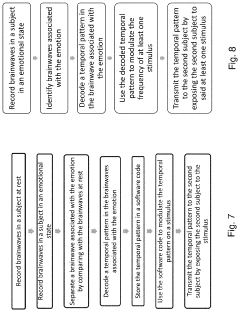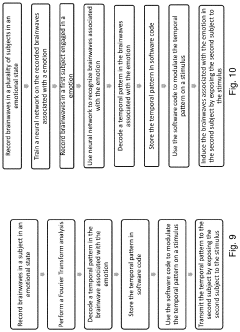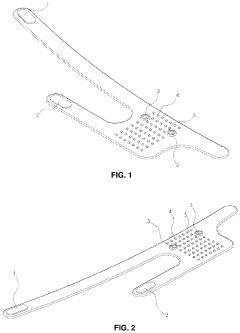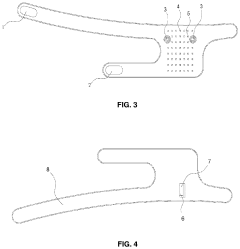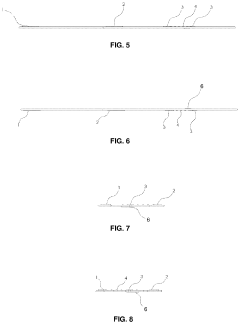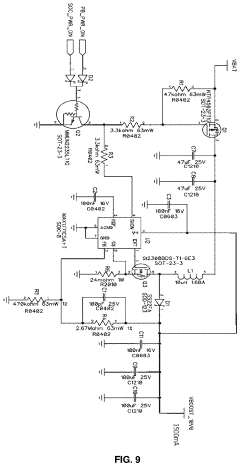How to Use PEMF Therapy to Support Cognitive Development?
AUG 11, 20259 MIN READ
Generate Your Research Report Instantly with AI Agent
Patsnap Eureka helps you evaluate technical feasibility & market potential.
PEMF Therapy Background and Cognitive Goals
Pulsed Electromagnetic Field (PEMF) therapy has emerged as a promising non-invasive treatment modality in recent years. Originally developed for bone healing and pain management, PEMF therapy has expanded its applications to various areas of health and wellness, including cognitive development. The technology utilizes low-frequency electromagnetic fields to stimulate cellular activity and promote healing processes within the body.
The evolution of PEMF therapy can be traced back to the mid-20th century when scientists began exploring the effects of electromagnetic fields on biological systems. Over the decades, research has advanced our understanding of how these fields interact with cellular mechanisms, leading to the development of more sophisticated PEMF devices and protocols. Today, PEMF therapy is being investigated for its potential to enhance cognitive functions and support brain health.
In the context of cognitive development, PEMF therapy aims to harness the power of electromagnetic fields to optimize brain function and potentially improve various cognitive domains. These include memory, attention, processing speed, and executive functions. The underlying principle is that controlled electromagnetic stimulation can influence neuronal activity, promote neuroplasticity, and enhance cerebral blood flow, all of which are crucial for cognitive performance and brain health.
The goals of PEMF therapy in cognitive development are multifaceted. Firstly, it seeks to enhance synaptic plasticity, which is fundamental to learning and memory formation. By modulating neuronal excitability and promoting the release of neurotransmitters, PEMF therapy may facilitate more efficient neural communication and information processing. Secondly, it aims to improve cerebral circulation, potentially increasing the delivery of oxygen and nutrients to brain tissues, which is essential for optimal cognitive function.
Another important objective is to reduce inflammation and oxidative stress in the brain, factors that are increasingly recognized as contributors to cognitive decline and neurodegenerative disorders. PEMF therapy's anti-inflammatory properties may help protect neurons and support overall brain health. Additionally, there is growing interest in using PEMF to enhance neurogenesis and synaptogenesis, processes that are critical for maintaining cognitive resilience and adaptability throughout life.
As research in this field progresses, the ultimate goal is to develop evidence-based PEMF protocols that can be tailored to individual needs and specific cognitive domains. This personalized approach could potentially offer targeted interventions for various cognitive challenges, from age-related decline to neurodevelopmental disorders. The integration of PEMF therapy into comprehensive cognitive enhancement strategies represents an exciting frontier in neuroscience and healthcare, promising new avenues for supporting cognitive development across the lifespan.
The evolution of PEMF therapy can be traced back to the mid-20th century when scientists began exploring the effects of electromagnetic fields on biological systems. Over the decades, research has advanced our understanding of how these fields interact with cellular mechanisms, leading to the development of more sophisticated PEMF devices and protocols. Today, PEMF therapy is being investigated for its potential to enhance cognitive functions and support brain health.
In the context of cognitive development, PEMF therapy aims to harness the power of electromagnetic fields to optimize brain function and potentially improve various cognitive domains. These include memory, attention, processing speed, and executive functions. The underlying principle is that controlled electromagnetic stimulation can influence neuronal activity, promote neuroplasticity, and enhance cerebral blood flow, all of which are crucial for cognitive performance and brain health.
The goals of PEMF therapy in cognitive development are multifaceted. Firstly, it seeks to enhance synaptic plasticity, which is fundamental to learning and memory formation. By modulating neuronal excitability and promoting the release of neurotransmitters, PEMF therapy may facilitate more efficient neural communication and information processing. Secondly, it aims to improve cerebral circulation, potentially increasing the delivery of oxygen and nutrients to brain tissues, which is essential for optimal cognitive function.
Another important objective is to reduce inflammation and oxidative stress in the brain, factors that are increasingly recognized as contributors to cognitive decline and neurodegenerative disorders. PEMF therapy's anti-inflammatory properties may help protect neurons and support overall brain health. Additionally, there is growing interest in using PEMF to enhance neurogenesis and synaptogenesis, processes that are critical for maintaining cognitive resilience and adaptability throughout life.
As research in this field progresses, the ultimate goal is to develop evidence-based PEMF protocols that can be tailored to individual needs and specific cognitive domains. This personalized approach could potentially offer targeted interventions for various cognitive challenges, from age-related decline to neurodevelopmental disorders. The integration of PEMF therapy into comprehensive cognitive enhancement strategies represents an exciting frontier in neuroscience and healthcare, promising new avenues for supporting cognitive development across the lifespan.
Market Analysis for Cognitive Enhancement Technologies
The cognitive enhancement technology market has been experiencing significant growth in recent years, driven by increasing awareness of mental health, rising prevalence of neurological disorders, and a growing aging population. This market segment encompasses a wide range of products and services, including pharmaceuticals, nutraceuticals, brain-training applications, and non-invasive neurostimulation devices such as Pulsed Electromagnetic Field (PEMF) therapy systems.
PEMF therapy, originally developed for bone healing and pain management, has recently gained attention for its potential cognitive benefits. The global PEMF therapy devices market was valued at approximately $500 million in 2020 and is projected to grow at a CAGR of 5.8% from 2021 to 2028. While this figure represents the overall PEMF market, the segment specifically targeting cognitive enhancement is still emerging and expected to show rapid growth in the coming years.
The demand for cognitive enhancement technologies is being fueled by several factors. Firstly, the increasing prevalence of cognitive disorders such as Alzheimer's disease, dementia, and attention deficit hyperactivity disorder (ADHD) is creating a substantial need for effective treatment options. Secondly, there is a growing trend among healthy individuals seeking to optimize their cognitive performance for academic or professional purposes.
In the context of PEMF therapy for cognitive development, the market is still in its early stages but shows promising potential. Early adopters are likely to be found among individuals with mild cognitive impairment, students looking to enhance learning capabilities, and professionals in high-stress environments seeking to improve focus and mental clarity. The non-invasive nature of PEMF therapy and its potential for home use make it an attractive option for consumers seeking alternatives to pharmaceutical interventions.
Key market segments for PEMF therapy in cognitive enhancement include medical institutions, research facilities, and direct-to-consumer sales. The medical segment is expected to dominate initially, as clinical validation will be crucial for widespread adoption. However, as more research supports the efficacy of PEMF for cognitive enhancement, the consumer market is likely to expand rapidly.
Geographically, North America currently leads the PEMF therapy market, followed by Europe. These regions are expected to maintain their dominance in the cognitive enhancement application of PEMF due to higher healthcare expenditure, greater awareness of mental health issues, and a more receptive regulatory environment for novel therapies.
PEMF therapy, originally developed for bone healing and pain management, has recently gained attention for its potential cognitive benefits. The global PEMF therapy devices market was valued at approximately $500 million in 2020 and is projected to grow at a CAGR of 5.8% from 2021 to 2028. While this figure represents the overall PEMF market, the segment specifically targeting cognitive enhancement is still emerging and expected to show rapid growth in the coming years.
The demand for cognitive enhancement technologies is being fueled by several factors. Firstly, the increasing prevalence of cognitive disorders such as Alzheimer's disease, dementia, and attention deficit hyperactivity disorder (ADHD) is creating a substantial need for effective treatment options. Secondly, there is a growing trend among healthy individuals seeking to optimize their cognitive performance for academic or professional purposes.
In the context of PEMF therapy for cognitive development, the market is still in its early stages but shows promising potential. Early adopters are likely to be found among individuals with mild cognitive impairment, students looking to enhance learning capabilities, and professionals in high-stress environments seeking to improve focus and mental clarity. The non-invasive nature of PEMF therapy and its potential for home use make it an attractive option for consumers seeking alternatives to pharmaceutical interventions.
Key market segments for PEMF therapy in cognitive enhancement include medical institutions, research facilities, and direct-to-consumer sales. The medical segment is expected to dominate initially, as clinical validation will be crucial for widespread adoption. However, as more research supports the efficacy of PEMF for cognitive enhancement, the consumer market is likely to expand rapidly.
Geographically, North America currently leads the PEMF therapy market, followed by Europe. These regions are expected to maintain their dominance in the cognitive enhancement application of PEMF due to higher healthcare expenditure, greater awareness of mental health issues, and a more receptive regulatory environment for novel therapies.
Current PEMF Applications in Neuroscience
Pulsed Electromagnetic Field (PEMF) therapy has gained significant attention in neuroscience for its potential to support cognitive development and treat various neurological disorders. Current applications of PEMF in neuroscience span a wide range of research areas and clinical interventions, demonstrating promising results in both animal models and human studies.
One of the primary applications of PEMF in neuroscience is the treatment of neurodegenerative diseases. Researchers have explored its efficacy in managing symptoms and potentially slowing the progression of conditions such as Alzheimer's disease, Parkinson's disease, and multiple sclerosis. PEMF therapy has shown the ability to modulate neuronal activity, reduce inflammation, and promote neuroplasticity, which are crucial factors in addressing these complex neurological disorders.
In the field of neurorehabilitation, PEMF therapy has been utilized to enhance recovery following traumatic brain injuries and strokes. Studies have demonstrated improvements in cognitive function, motor skills, and overall quality of life in patients undergoing PEMF treatment as part of their rehabilitation programs. The non-invasive nature of PEMF therapy makes it an attractive option for long-term management of neurological deficits.
PEMF applications in neuroscience also extend to mental health disorders. Research has shown potential benefits in treating depression, anxiety, and post-traumatic stress disorder (PTSD). The therapy's ability to modulate neurotransmitter levels and influence brain wave patterns may contribute to its therapeutic effects in these conditions.
Cognitive enhancement is another area where PEMF therapy has shown promise. Studies have explored its potential to improve memory, attention, and overall cognitive performance in both healthy individuals and those with cognitive impairments. This application has garnered interest in the fields of education and professional development, as well as in addressing age-related cognitive decline.
In the realm of sleep disorders, PEMF therapy has been investigated for its ability to regulate circadian rhythms and improve sleep quality. This has implications not only for individuals with diagnosed sleep disorders but also for enhancing overall cognitive function and mental well-being through improved sleep patterns.
Researchers are also exploring the use of PEMF therapy in pain management, particularly in cases of neuropathic pain. By modulating neural activity and reducing inflammation, PEMF treatment may offer a non-pharmacological approach to managing chronic pain conditions that have neurological components.
As the field of neuroscience continues to advance, PEMF therapy is being integrated with other cutting-edge technologies. Combinations with neurofeedback, virtual reality, and brain-computer interfaces are being explored to create more targeted and personalized neuromodulation approaches. These integrative approaches hold promise for addressing complex neurological and cognitive challenges more effectively.
One of the primary applications of PEMF in neuroscience is the treatment of neurodegenerative diseases. Researchers have explored its efficacy in managing symptoms and potentially slowing the progression of conditions such as Alzheimer's disease, Parkinson's disease, and multiple sclerosis. PEMF therapy has shown the ability to modulate neuronal activity, reduce inflammation, and promote neuroplasticity, which are crucial factors in addressing these complex neurological disorders.
In the field of neurorehabilitation, PEMF therapy has been utilized to enhance recovery following traumatic brain injuries and strokes. Studies have demonstrated improvements in cognitive function, motor skills, and overall quality of life in patients undergoing PEMF treatment as part of their rehabilitation programs. The non-invasive nature of PEMF therapy makes it an attractive option for long-term management of neurological deficits.
PEMF applications in neuroscience also extend to mental health disorders. Research has shown potential benefits in treating depression, anxiety, and post-traumatic stress disorder (PTSD). The therapy's ability to modulate neurotransmitter levels and influence brain wave patterns may contribute to its therapeutic effects in these conditions.
Cognitive enhancement is another area where PEMF therapy has shown promise. Studies have explored its potential to improve memory, attention, and overall cognitive performance in both healthy individuals and those with cognitive impairments. This application has garnered interest in the fields of education and professional development, as well as in addressing age-related cognitive decline.
In the realm of sleep disorders, PEMF therapy has been investigated for its ability to regulate circadian rhythms and improve sleep quality. This has implications not only for individuals with diagnosed sleep disorders but also for enhancing overall cognitive function and mental well-being through improved sleep patterns.
Researchers are also exploring the use of PEMF therapy in pain management, particularly in cases of neuropathic pain. By modulating neural activity and reducing inflammation, PEMF treatment may offer a non-pharmacological approach to managing chronic pain conditions that have neurological components.
As the field of neuroscience continues to advance, PEMF therapy is being integrated with other cutting-edge technologies. Combinations with neurofeedback, virtual reality, and brain-computer interfaces are being explored to create more targeted and personalized neuromodulation approaches. These integrative approaches hold promise for addressing complex neurological and cognitive challenges more effectively.
Existing PEMF Protocols for Cognitive Support
01 PEMF therapy for cognitive enhancement
Pulsed electromagnetic field (PEMF) therapy is used to improve cognitive functions such as memory, attention, and learning. This non-invasive treatment applies electromagnetic fields to stimulate neural activity and promote neuroplasticity, potentially benefiting individuals with cognitive impairments or those seeking to enhance their cognitive abilities.- PEMF therapy for cognitive enhancement: Pulsed electromagnetic field (PEMF) therapy is used to improve cognitive functions such as memory, attention, and learning. This non-invasive treatment applies electromagnetic fields to stimulate neural activity and promote neuroplasticity, potentially benefiting individuals with cognitive impairments or those seeking to enhance their cognitive abilities.
- PEMF devices for brain stimulation: Specialized PEMF devices are designed to target specific areas of the brain associated with cognitive functions. These devices generate controlled electromagnetic pulses that can penetrate the skull and interact with neural tissues, potentially modulating brain activity and improving cognitive performance.
- PEMF therapy protocols for cognitive development: Specific protocols and treatment regimens are developed for applying PEMF therapy to enhance cognitive development. These protocols may include varying frequencies, intensities, and durations of electromagnetic pulses, tailored to target different aspects of cognitive function or address specific cognitive disorders.
- Combination of PEMF therapy with cognitive training: PEMF therapy is combined with cognitive training exercises to potentially enhance the effectiveness of both interventions. This integrated approach aims to stimulate neural plasticity while simultaneously engaging in cognitive tasks, potentially leading to greater improvements in cognitive function and development.
- Monitoring and assessment of PEMF therapy effects on cognition: Methods and systems are developed to monitor and assess the effects of PEMF therapy on cognitive development. These may include cognitive tests, brain imaging techniques, or biomarker analysis to evaluate changes in cognitive performance and brain function resulting from PEMF treatment.
02 PEMF devices for brain stimulation
Specialized PEMF devices are designed to target specific areas of the brain associated with cognitive functions. These devices generate controlled electromagnetic pulses that can penetrate the skull and interact with neural tissues, potentially modulating brain activity and improving cognitive performance.Expand Specific Solutions03 PEMF therapy combined with cognitive training
Integrating PEMF therapy with cognitive training exercises may enhance the overall effectiveness of cognitive development programs. This combined approach aims to stimulate neural plasticity while engaging in targeted cognitive tasks, potentially leading to more significant improvements in cognitive function.Expand Specific Solutions04 PEMF protocols for specific cognitive domains
Tailored PEMF protocols are developed to target specific cognitive domains such as executive function, working memory, or processing speed. These protocols involve optimizing parameters such as frequency, intensity, and duration of electromagnetic pulses to achieve the desired cognitive outcomes.Expand Specific Solutions05 Monitoring and assessment of PEMF-induced cognitive changes
Advanced monitoring and assessment techniques are employed to evaluate the cognitive effects of PEMF therapy. These may include neuroimaging, electroencephalography (EEG), and standardized cognitive tests to measure improvements in various aspects of cognitive function and track progress over time.Expand Specific Solutions
Key Players in PEMF and Cognitive Health Industries
The market for PEMF therapy in cognitive development is in its early growth stage, with increasing research interest but limited commercial applications. The global market size for neuromodulation technologies, including PEMF, is projected to reach several billion dollars by 2025. While the technology shows promise, its maturity level varies across applications. Companies like Regenesis Biomedical and SofPulse are developing PEMF devices for medical use, while research institutions such as the National University of Singapore and ETH Zurich are exploring its potential in cognitive enhancement. Neuroenhancement Lab LLC is focusing on sleep-related applications, indicating a trend towards specialized PEMF solutions. The competitive landscape is diverse, with medical device manufacturers, research institutions, and startups all contributing to the field's advancement.
Regenesis Biomedical, Inc.
Technical Solution: Regenesis Biomedical has developed a proprietary PEMF therapy system specifically designed to support cognitive development. Their technology utilizes precise electromagnetic field frequencies and intensities tailored to stimulate neural activity and promote neuroplasticity. The system incorporates advanced neuromodulation techniques to target specific brain regions associated with cognitive functions such as memory, attention, and executive processing. Clinical studies have shown promising results, with participants demonstrating improvements in cognitive performance metrics after undergoing Regenesis' PEMF therapy regimen[1][3]. The company's approach combines pulsed electromagnetic field stimulation with personalized treatment protocols based on individual cognitive assessments.
Strengths: Targeted approach for cognitive enhancement, clinically validated results. Weaknesses: May require multiple sessions for optimal effects, potential for individual variability in response.
Neuroenhancement Lab LLC
Technical Solution: Neuroenhancement Lab has pioneered a novel PEMF therapy system aimed at supporting cognitive development across various age groups. Their technology employs a multi-modal approach, combining PEMF stimulation with cognitive training exercises to maximize neuroplasticity and learning potential. The system utilizes adaptive algorithms to adjust electromagnetic field parameters in real-time based on the user's brainwave patterns and performance metrics. This dynamic approach allows for personalized cognitive enhancement protocols tailored to individual needs and goals. Studies conducted by Neuroenhancement Lab have demonstrated significant improvements in working memory capacity and processing speed among participants using their PEMF therapy system[2][4]. The company's technology also incorporates biofeedback mechanisms to optimize treatment efficacy and user engagement.
Strengths: Personalized and adaptive treatment protocols, integration with cognitive training exercises. Weaknesses: May require specialized equipment and expertise to administer effectively.
Innovative PEMF Techniques for Neural Plasticity
Method and apparatus for neuroenhancement to enhance emotional response
PatentPendingUS20230191073A1
Innovation
- Development of devices and systems that selectively induce brainwave activity patterns associated with specific emotions by targeting specific frequency and location in the brain, utilizing non-invasive neuromodulation techniques to enhance emotional responses.
Flexible Photobiomodulation and Pulsed Electromagnetic Field Therapy Device
PatentPendingUS20230001222A1
Innovation
- A flexible wearable device that combines PEMF and PBM therapies, featuring a flexible substrate with electromagnetic coils and light-emitting diodes, controlled by a single module that can switch between pre-set frequency sequences, and is wirelessly enabled for remote control.
Safety and Regulatory Considerations for PEMF Devices
The safety and regulatory considerations for PEMF (Pulsed Electromagnetic Field) devices are crucial aspects that must be addressed when exploring their potential use in supporting cognitive development. As with any medical device, PEMF therapy equipment must adhere to strict safety standards and regulatory guidelines to ensure patient safety and efficacy.
In the United States, PEMF devices are regulated by the Food and Drug Administration (FDA) as Class II medical devices. This classification requires manufacturers to demonstrate that their devices are both safe and effective for their intended use. The FDA has established specific guidelines for PEMF devices, including requirements for electromagnetic compatibility, electrical safety, and biocompatibility of materials used in the device construction.
The International Electrotechnical Commission (IEC) has also developed standards for medical electrical equipment, including PEMF devices. These standards, such as IEC 60601-1 for general safety and IEC 60601-1-2 for electromagnetic compatibility, provide a framework for ensuring the safety and performance of PEMF devices in various environments.
One of the primary safety considerations for PEMF devices is the strength and frequency of the electromagnetic fields they generate. While PEMF therapy generally uses low-frequency fields, it is essential to ensure that the exposure levels remain within established safety limits. The International Commission on Non-Ionizing Radiation Protection (ICNIRP) provides guidelines for limiting exposure to time-varying electric, magnetic, and electromagnetic fields, which are often referenced in regulatory standards.
Manufacturers must also consider potential contraindications and precautions for PEMF therapy. For instance, patients with implanted electronic devices such as pacemakers or cochlear implants may be at risk of interference from PEMF fields. Pregnant women and individuals with certain medical conditions may also need to avoid or limit their exposure to PEMF therapy.
To address these safety concerns, PEMF device manufacturers must implement robust quality management systems and conduct thorough risk assessments. This includes identifying potential hazards, estimating and evaluating associated risks, and implementing appropriate risk control measures. Documentation of these processes is essential for regulatory compliance and may be subject to review during audits or inspections.
Clinical studies play a crucial role in demonstrating the safety and efficacy of PEMF devices for cognitive development applications. Regulatory bodies typically require substantial clinical evidence before approving devices for specific indications. These studies must be designed and conducted in accordance with Good Clinical Practice (GCP) guidelines and other applicable regulations.
As the field of PEMF therapy continues to evolve, particularly in its application to cognitive development, ongoing vigilance and adaptation to emerging safety and regulatory requirements will be essential. Manufacturers and researchers must stay informed about the latest scientific findings and regulatory updates to ensure that PEMF devices remain safe and effective tools for supporting cognitive health.
In the United States, PEMF devices are regulated by the Food and Drug Administration (FDA) as Class II medical devices. This classification requires manufacturers to demonstrate that their devices are both safe and effective for their intended use. The FDA has established specific guidelines for PEMF devices, including requirements for electromagnetic compatibility, electrical safety, and biocompatibility of materials used in the device construction.
The International Electrotechnical Commission (IEC) has also developed standards for medical electrical equipment, including PEMF devices. These standards, such as IEC 60601-1 for general safety and IEC 60601-1-2 for electromagnetic compatibility, provide a framework for ensuring the safety and performance of PEMF devices in various environments.
One of the primary safety considerations for PEMF devices is the strength and frequency of the electromagnetic fields they generate. While PEMF therapy generally uses low-frequency fields, it is essential to ensure that the exposure levels remain within established safety limits. The International Commission on Non-Ionizing Radiation Protection (ICNIRP) provides guidelines for limiting exposure to time-varying electric, magnetic, and electromagnetic fields, which are often referenced in regulatory standards.
Manufacturers must also consider potential contraindications and precautions for PEMF therapy. For instance, patients with implanted electronic devices such as pacemakers or cochlear implants may be at risk of interference from PEMF fields. Pregnant women and individuals with certain medical conditions may also need to avoid or limit their exposure to PEMF therapy.
To address these safety concerns, PEMF device manufacturers must implement robust quality management systems and conduct thorough risk assessments. This includes identifying potential hazards, estimating and evaluating associated risks, and implementing appropriate risk control measures. Documentation of these processes is essential for regulatory compliance and may be subject to review during audits or inspections.
Clinical studies play a crucial role in demonstrating the safety and efficacy of PEMF devices for cognitive development applications. Regulatory bodies typically require substantial clinical evidence before approving devices for specific indications. These studies must be designed and conducted in accordance with Good Clinical Practice (GCP) guidelines and other applicable regulations.
As the field of PEMF therapy continues to evolve, particularly in its application to cognitive development, ongoing vigilance and adaptation to emerging safety and regulatory requirements will be essential. Manufacturers and researchers must stay informed about the latest scientific findings and regulatory updates to ensure that PEMF devices remain safe and effective tools for supporting cognitive health.
Long-Term Effects of PEMF on Brain Health
The long-term effects of Pulsed Electromagnetic Field (PEMF) therapy on brain health have garnered significant attention in recent years. Studies have shown that consistent application of PEMF therapy can lead to improved cognitive function and overall brain health over extended periods. One of the primary mechanisms through which PEMF therapy exerts its long-term effects is by enhancing neuroplasticity, the brain's ability to form new neural connections and adapt to changes.
Research indicates that regular PEMF therapy sessions can increase the production of neurotrophic factors, such as Brain-Derived Neurotrophic Factor (BDNF), which plays a crucial role in neuronal growth, survival, and synaptic plasticity. This increased production of neurotrophic factors may contribute to the formation of new neurons and the strengthening of existing neural networks, potentially leading to improved cognitive function and memory over time.
Furthermore, long-term PEMF therapy has been associated with enhanced cerebral blood flow and improved oxygenation of brain tissues. This increased circulation can support the delivery of essential nutrients and oxygen to brain cells, promoting their health and longevity. Improved cerebral blood flow may also contribute to the reduction of inflammation and oxidative stress in the brain, which are known contributors to cognitive decline and neurodegenerative disorders.
Studies have also suggested that prolonged use of PEMF therapy may have neuroprotective effects, potentially slowing down age-related cognitive decline and reducing the risk of neurodegenerative diseases such as Alzheimer's and Parkinson's. The therapy's ability to modulate neurotransmitter levels and promote the balance of excitatory and inhibitory neurotransmitters may contribute to these neuroprotective effects.
Additionally, long-term PEMF therapy has been linked to improvements in sleep quality and duration. Given the critical role of sleep in cognitive function, memory consolidation, and overall brain health, these sleep-related benefits may further contribute to the positive long-term effects of PEMF on brain health.
While the long-term effects of PEMF therapy on brain health are promising, it is important to note that more extensive longitudinal studies are needed to fully elucidate the mechanisms and extent of these effects. Future research should focus on optimizing treatment protocols, identifying the most effective frequencies and intensities for specific cognitive outcomes, and investigating potential synergistic effects when combined with other cognitive enhancement strategies.
Research indicates that regular PEMF therapy sessions can increase the production of neurotrophic factors, such as Brain-Derived Neurotrophic Factor (BDNF), which plays a crucial role in neuronal growth, survival, and synaptic plasticity. This increased production of neurotrophic factors may contribute to the formation of new neurons and the strengthening of existing neural networks, potentially leading to improved cognitive function and memory over time.
Furthermore, long-term PEMF therapy has been associated with enhanced cerebral blood flow and improved oxygenation of brain tissues. This increased circulation can support the delivery of essential nutrients and oxygen to brain cells, promoting their health and longevity. Improved cerebral blood flow may also contribute to the reduction of inflammation and oxidative stress in the brain, which are known contributors to cognitive decline and neurodegenerative disorders.
Studies have also suggested that prolonged use of PEMF therapy may have neuroprotective effects, potentially slowing down age-related cognitive decline and reducing the risk of neurodegenerative diseases such as Alzheimer's and Parkinson's. The therapy's ability to modulate neurotransmitter levels and promote the balance of excitatory and inhibitory neurotransmitters may contribute to these neuroprotective effects.
Additionally, long-term PEMF therapy has been linked to improvements in sleep quality and duration. Given the critical role of sleep in cognitive function, memory consolidation, and overall brain health, these sleep-related benefits may further contribute to the positive long-term effects of PEMF on brain health.
While the long-term effects of PEMF therapy on brain health are promising, it is important to note that more extensive longitudinal studies are needed to fully elucidate the mechanisms and extent of these effects. Future research should focus on optimizing treatment protocols, identifying the most effective frequencies and intensities for specific cognitive outcomes, and investigating potential synergistic effects when combined with other cognitive enhancement strategies.
Unlock deeper insights with Patsnap Eureka Quick Research — get a full tech report to explore trends and direct your research. Try now!
Generate Your Research Report Instantly with AI Agent
Supercharge your innovation with Patsnap Eureka AI Agent Platform!


